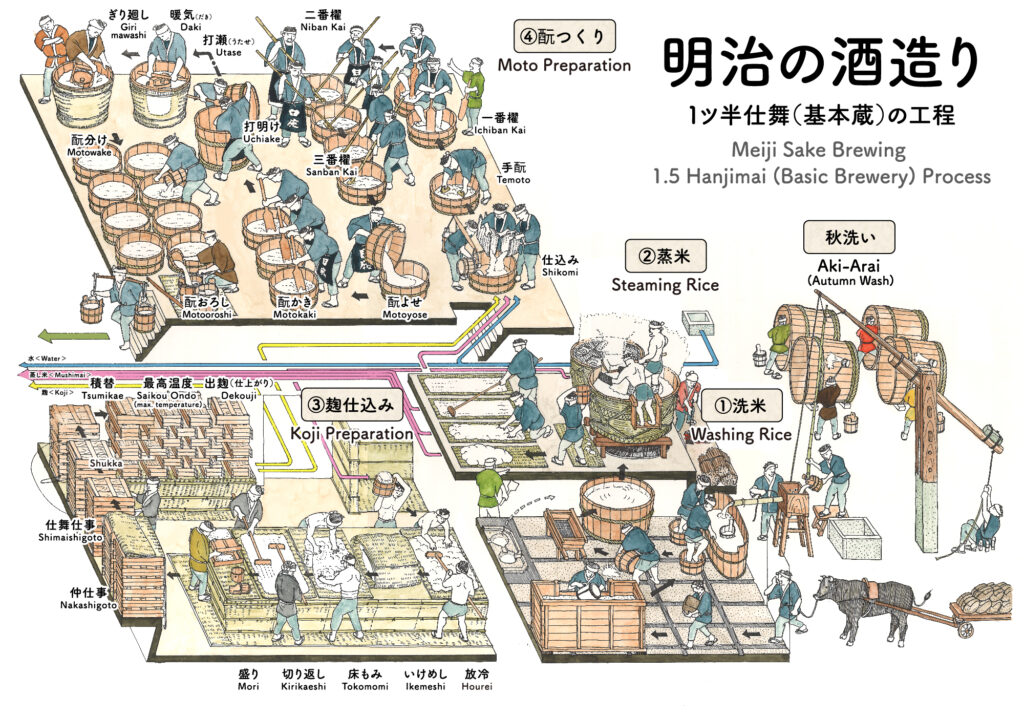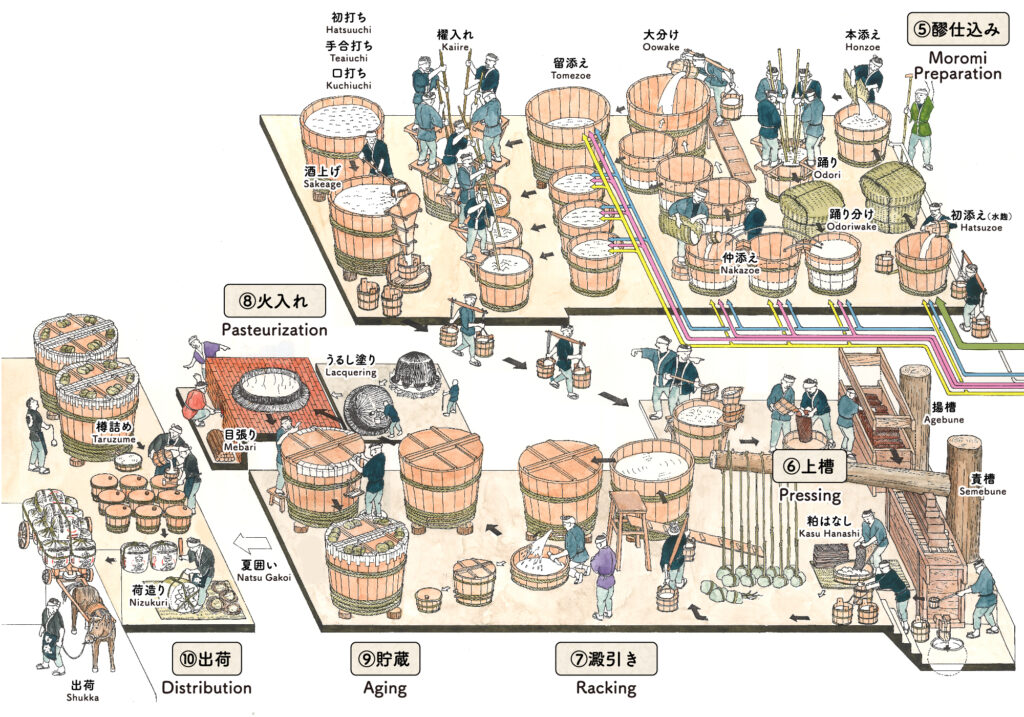Previous Article
Kyushu Ryuu (Kumamoto) Motosuri-ondo
Each stage of the sake brewing process has a sake brewing song. Let’s look into what songs were sung at what stage.


A drawing with reference to the Meiji era sake brewing at Tatsuuma-Honke Brewing Co., (brewers of Hakushika) that was reprinted with permission from an illustration published in “Quarterly Obayashi No.37, 1993, Nada Gogo”. The details of each process are carefully drawn, making it a valuable illustration that shows how sake brewing was conducted by hand during the period. The following explanation, which traces sake brewing with a focus on the amount of rice brewed, was created with reference to explanations by Mr. Miyasaka Takuya and Mr.Morita Hiroshi, a Tamba toji.
All text content on the image has been added by the Kokushu Digital Museum.
Source: “Nada Sake Brewery, Industrial Restoration” from Obayashi-Gumi’s “Quarterly Obayashi No.37, Nada Gogo”
© ︎TEM Research Institute Co., Ltd.
| Process Stage | Process Detail | Sake Brewing Song |
| Aki Arai (Autumn Wash) | Wash tools such as wooden vats in hot water for disinfection. | Arai-uta |
| 1:Washing Rice | Wash polished rice with water. | Komearai-uta |
| 2:Steaming Rice | Steam washed rice in koshiki. | |
| 3:Koji Preparation | Mix cooled steamed rice with moyashi (spores of koji mold) to make koji. | |
| 4:Moto Preparation | Mix steamed rice, koji, and water to make moto (starter mash). | Motosuri-uta, Motokaki-uta, Kaiire-uta, Kazoe-uta |
| 5:Moromi Preparation | Add steamed rice, koji, water, and moto into large wooden vats in three batches – hatsuzoe, nakazoe, and tomezoe – to prepare moromi (fermenting mash). This three-step preparation is called “sandan shikomi”. | Kaiire-uta, Kazoe-uta |
| 6:Pressing | Place moromi in cotton bags, line them in the wooden tub called “fune”, and apply pressure from the top to press the mash. | |
| 7:Racking | Transfer the liquid into vats and allow dregs to sink, separating out the clear liquid (sake). | |
| 8:Pasteurization | Transfer the clear supernatant sake into lacquered cauldrons and heat at about 60°C. | |
| 9:Aging | Transfer heated sake into vats, seal the lid with washi paper, and store until autumn. | |
| 10:Shipping | Pack sake in barrels for shipping. |
Sake brewing is a round-the-clock process of working with microorganisms. While sake is made by adding koji and water to steamed rice and fermenting it, the action of microorganisms is indispensable during this process. Koji enzymes break down starch and protein contained in steamed rice into glucose and amino acids, and yeast ferments the sugars into alcohol. As such, the growth of microorganisms is controlled, either by mixing and dividing the koji and moto to adjust its temperature, or activating the moto and moromi to promote fermentation.
The title of this illustration, ‘1.5 Hanjimai (Basic Brewery)’, represents the production capacity (scale) of the sake brewery. The production scale of a brewery is usually expressed in ‘koku’. Koku is a unit that indicates the quantity, with 1 koku converting to 10 to, 100 sho, or about 180 liters. As a guideline for the production capacity of a brewery, the amount of sake rice used in one day (the amount that can be processed from polished rice to steamed rice) is expressed in koku.
At the same time, the scale of production was sometimes expressed in units called ‘hanjimai’. One hanjimai refers to 5 koku (750kg), thus the ‘1.5 hanjimai brewery’ shown in the illustration would have been able to steam up to three times of 1 hanjimai, or 15 koku (2250kg) of white rice per day.
Sake brewing is conducted by a team of brewers led by a Toji, with a minimum of 6 people per half ‘hanjimai’, so the 1.5-hanjimai brewery shown in this illustration consists of 18 people. The brewers sing songs to match the rhythm of sake brewing and to boost morale during the harsh working conditions of winter.
The 1.5 hanjimai brewery is also called the ‘basic brewery’, using 15 koku of white rice (steamed rice and koji) and 18 koku of Miyamizu water to prepare one vat of moromi (33 koku). If all 33 vats are prepared, 1089 koku of moromi can be made in one winter, and after accounting for loss during the process and the amount of lees, approximately 1000 koku (180,000 liters) of sake can be produced. That is how the phrase ‘senkoku kura (1000 koku brewery)’ came about, because of the amount of sake produced.